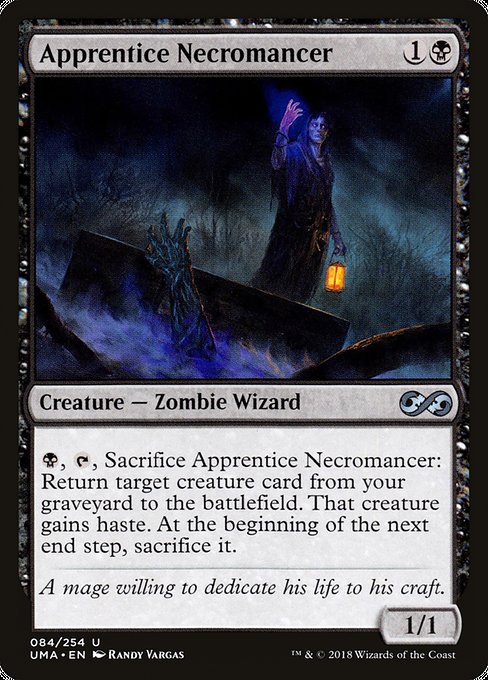
Image courtesy of Scryfall.com
Navigating Buyouts and the Pulse of Small-Set Magic
In the Magic: The Gathering ecosystem, buyouts aren’t just a headline on a price-tracker—they reshape accessibility, deckbuilding, and even culture around specific cards. When a small-set card surfaces in high demand, especially an uncommon from a Masters-era reprint like Apprentice Necromancer, the market can swing in ways that casual players feel in their budget and their stacks. 🧙♂️ It’s not about pushing a single card to “champion status” but about understanding how constrained supply meets intense interest in a format that loves graveyard shenanigans and tempo plays. 🔥
Apprentice Necromancer is a perfect lens for this discussion. This black mana cost two-drop creature—Zombie Wizard—lends itself to graveyard-centric strategies with a twist. Its ability is conceptually simple but potent: pay {B}, tap, sacrifice this creature to return target creature card from your graveyard to the battlefield. That returned creature gains haste, and at the beginning of the next end step, you sacrifice it. The loop is not infinite, but it creates a dramatic, tempo-rich play pattern. You trade a body for a surge of tempo and potential surprise damage, which can feel like a mini-tournament spark in a casual kitchen-table game. ⚔️
From a market perspective, the card’s scarcity is real and the price reflects a blend of nostalgia, casual demand, and the particular pressure points of the Ultimate Masters (UMA) print run. UMA itself was a treasure trove for reprints, but it’s still a finite print with a distinct, collector-friendly footprint. Uncommons in Masters sets are often the trickiest—valuable enough to entice speculators, but not so rare that a dedicated player base can comfortably stock up. Apprentice Necromancer sits in that zone where modern reprint cycles, foil options, and EDH-level interest all collide. Today, you’ll find that it’s around a modest USD price in the sub-dollar range for non-foil copies, with foil versions climbing higher due to demand for shiny showcases in casual and EDH games. The data snapshot shows roughly $0.77 USD for non-foil, and about $3.96 USD for foil, with euros around €1.38 non-foil and €3.08 foil. Those numbers are a reminder that even small-set staples live in a volatile domain where supply and appetite aren’t always in perfect harmony. 💎
So what happens when a buyout hits a card like Apprentice Necromancer? First, short-term price spikes are common as speculators pull a few dozen or hundred copies off the market, creating a perception of scarcity. That can be exciting for collectors, but it can also erode accessibility for players who want to build decks around reanimation themes. Second, the market tends to correct after the initial wave—especially for print-on-demand or reprint-friendly cards. UMA’s reprint status means that while the card is available in foil and non-foil, it’s not a guaranteed eternal presence in standard-legal ecosystems. While that uncertainty can fuel speculative activity, it also keeps a healthy tension for deck builders who rely on a steady supply of reanimator tools. 🔥
Strategically, Apprentice Necromancer shines in decks that embrace the graveyard as a resource—think builds that leverage targeted revivals and tempo plays. The sacrifice requirement pushes you to plan your sequencing carefully: you don’t just throw it onto the battlefield and hope for value; you set up the graveyard with chosen targets, time the reanimated threat for a window of impact, and then respect the temporary nature of the effect. It pairs nicely with sacrifice outlets, bounce effects, and cards that reward haste or temporary haste windows. In a world where buyouts can distort price, a player who values playability over hype finds that the card’s utility remains steady—especially in EDH where the card’s quirks can fuel interesting, recurring lines of play. 🧙♂️🎲
Beyond raw playability, small-set cards like Apprentice Necromancer also tell a broader story about how design intent travels through the market. The card’s flavor line—“A mage willing to dedicate his life to his craft”—pairs with its mechanical theme: a focused, if fleeting, mastery over fallen power. In the era of UMA, that flavor mirrors how collectors chase both the art and the story behind a card’s reappearance in print, foil treatment, and collector boosters. For budding collectors and seasoned fans alike, it’s a reminder that even a relatively modest uncommon can command attention when it sits at the crossroads of nostalgia, playability, and scarcity. 🎨
For readers who want to translate these market dynamics into real-world purchases, remember to balance your love for the game with prudent buying. Look at price trends over several months, consider foil vs. non-foil trajectories, and watch for reprint news and set rotations that can alter supply. And if you’re browsing while you plan your next big reanimation turn, you might as well do so in comfort—hence the delightful cross-promo below. 🧙♂️🔥💎
Custom Neon Mouse Pad 9.3x7.8 in Non-slip Desk PadMore from our network
- https://crypto-acolytes.xyz/blog/post/blue-white-giant-in-ara-reveals-parallax-distance-uncertainty/
- https://transparent-paper.shop/blog/post/designing-pitch-deck-slides-for-freelancers-a-quick-guide/
- https://crypto-acolytes.xyz/blog/post/stellar-cartography-artistry-and-precision-in-a-dorado-beacon/
- https://blog.digital-vault.xyz/blog/post/un-set-origins-zimone-paradox-sculptors-curious-tale/
- https://transparent-paper.shop/blog/post/how-to-use-product-hunt-effectively-for-maximum-impact/